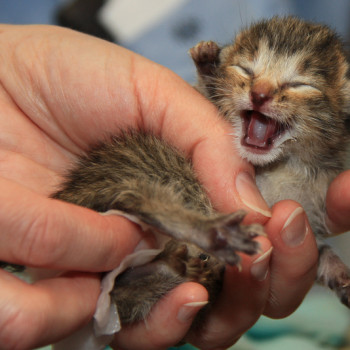When it comes to doing a physical exam on a newborn puppy or kitten, does your shelter or rescue group’s care team know what to look for?
At the 2015 NAVC veterinary conference, Elizabeth Thomovsky, DVM, MS, DACVECC, of the College of Veterinary Medicine at Purdue University, spoke on “What to Expect in a Neonatal Kitten or Puppy,” outlining the many ways in which very young animals differ from adults or even older puppies and kittens. This effect covers everything from sleep patterns to eating, temperature control to kidney and liver function, and more. Not understanding the unique needs and “normals” of these extremely fragile animals can cost them their lives.
Her advice to the audience? When it comes to physical exams on neonates, knowing what to expect is key. This includes (paragraph breaks added for readability):
The umbilicus will be present until about 3 days. Mucous membranes will be dark pink or red for one week and then will become pale. The respiratory rate is 30 bpm from about 30 hours post-birth.
The heart rate is faster than an adult: kitten heart rates are >250 bpm for the first 4 weeks and puppy heart rates are >160 bpm. The lack of parasympathetic nervous system (PNS) tone prevents neonates from having a sinus arrhythmia until they are more than 1 month old; any arrhythmia in a neonate is pathologic. Audible heart murmurs are innocent until the puppy or kitten is 12 weeks of age.
The blood pressure in a neonate is lower than an adult until at least 1 month.
When performing blood sampling in a neonate, it is important to remember the following points:
- The jugular vein is the only reasonable vessel. Collection from peripheral vessels causes hemolysis secondary to sample collection.
- DO NOT use alcohol (cools the patient too much).
- Hematoma formation is detrimental to a neonate since it represents significant loss of blood. In some cases, this can cause airway obstruction.
- Do not collect more than 10% of a patient’s blood volume in a 24-hour span. The blood volume of a neonate is 68 to 75 mL/kg (i.e., a 100-g newborn kitten only has 6 mL of blood in its body!).
Radiographs can be taken but are hard to interpret due to patient size, lack of abdominal fat (reduced abdominal contrast), and poorly mineralized bones.
VetFolio subscribers can access the complete proceedings of Dr. Thomovsky’s presentation, including slides, here.
Also of interest:
Critical care of the sick neonatal kitten
Orphaned kitten care how-to videos
Caring for orphaned kittens: A how-to guide for shelters
Orphaned kittens: Saving the tiniest lives
Don’t miss the rest of our great content — sign up here!

